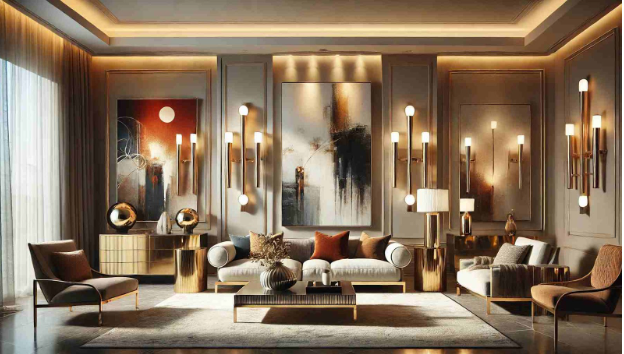Creating Visual Impact with Luxury Wall Lights and Art

Introduction
Creating a beautiful home goes beyond just selecting furniture and decor; it’s about combining elements in a way that expresses your unique style. Two powerful components in this journey are lighting and art, which, when paired thoughtfully, can dramatically elevate the look and feel of any space. This article explores how luxury wall lights and luxury wall art work together to create visual impact, enhance ambiance, and give any room a sophisticated, gallery-like quality.
Understanding the Role of Lighting in Highlighting Art
Types of Luxury Wall Lights for Art Illumination
The right lighting can bring art to life, emphasizing its colors, textures, and depth. Choosing the ideal type of wall lighting can help create a focal point in the room, drawing attention to the art while complementing its aesthetic. Here are some luxury wall lighting options perfect for art illumination:
- Sconces – Wall sconces are versatile and elegant fixtures that can either blend into a room’s decor or stand out as statement pieces. When placed on either side of a painting or sculpture, sconces can cast a soft, ambient glow that accentuates the artwork and adds symmetry to the display.
- Picture Lights – These lights are designed specifically for highlighting art. They attach to the wall or frame above the artwork, casting a focused beam that brings out the details and colors. Picture lights work well in spaces where you want the art to be the center of attention.
- Accent Lights – Accent lights are small, adjustable lights that can be directed at specific art pieces. They’re ideal for adding emphasis to a gallery wall or a single prominent artwork, allowing flexibility in how you illuminate each piece.
Choosing the Right Light Temperature and Brightness
When illuminating art, light temperature and brightness play a crucial role in ensuring the colors appear as intended without causing damage over time. For artwork, a light temperature around 2700K to 3000K (warm white) is often ideal, as it provides a warm glow that enhances the art’s colors without overpowering them. Avoid overly bright or harsh lighting, which can cause glare and distract from the art itself.
Adjustable brightness options are also a great feature to have. Dimmer switches allow you to control the intensity of the light based on the time of day or the room’s overall lighting. By keeping the lighting subtle and complementary, you ensure that the artwork remains the focal point.
Strategic Placement of Wall Lights to Enhance Visual Appeal
Creating Focal Points
Wall lights can be used to direct attention to specific art pieces, turning them into focal points within the room. For instance, installing sconces around a central painting or photograph can create a balanced, framed effect that draws the eye. Placing picture lights directly above a larger piece of art will make it the main attraction, allowing it to command the room.
To create a more dynamic look, consider placing accent lights on individual pieces within a gallery wall. This approach creates multiple focal points, offering depth and variety that keeps the eye engaged. The goal is to make each piece stand out in its own way while still contributing to the room’s overall ambiance.
Spacing and Balance
Achieving the right spacing and balance between wall lights and artwork is essential for a cohesive look. Symmetrical placements, such as sconces on either side of a single artwork, provide a formal and structured appearance, perfect for traditional or contemporary spaces. Alternatively, asymmetrical layouts, where lights are placed at varying heights or distances, can add a sense of movement and modernity.
Consider the room’s dimensions and layout when spacing wall lights and art. In smaller rooms, fewer, well-placed lights can provide sufficient illumination without overwhelming the space. In larger rooms, feel free to experiment with multiple lights and artworks, ensuring that each light has enough room to highlight its piece effectively.
Choosing Luxury Wall Art to Complement Lighting
Selecting Art Styles and Sizes
The type and style of art you select can greatly influence the effect of your wall lights. Large, bold pieces work well with picture lights or evenly spaced sconces, creating a central focus that can anchor the room. For a more eclectic look, opt for a mix of small and large artworks, combined with adjustable accent lights that allow you to shift focus as desired.
Consider the room’s design and your personal taste when selecting art. Classic landscapes or portraits, for example, lend themselves well to traditional lighting choices like warm sconces. Abstract or modern art may pair better with cooler-toned lights or minimalist accent fixtures that let the piece speak for itself.
Complementary Colors and Textures
Art should harmonize with the room’s lighting in terms of color and texture. If your wall lights feature brass or gold finishes, consider artwork with warm undertones, such as reds, yellows, or earth tones, to create a cohesive and inviting ambiance. For rooms with cool-toned lighting fixtures, artwork with blues, greens, or grays can create a modern and refreshing look.
Textured artwork, such as mixed-media pieces or paintings with thick brushstrokes, benefits from strategic lighting that highlights these details. Angle your wall lights slightly to cast gentle shadows, emphasizing the art’s texture and making it stand out from the wall.
Combining Wall Lights and Art for Maximum Impact
Layered Lighting for Depth
Layered lighting involves using different types of lights—ambient, accent, and task lighting—to add depth and dimension to a room. Ambient lighting provides overall illumination, while accent lighting, such as wall lights focused on art, adds visual interest. Task lighting, like floor or table lamps, can be positioned near seating areas to create cozy nooks.
This layering approach allows you to create a dynamic environment where the eye is drawn to various points of interest. By layering wall lights with ambient and task lighting, you can create a warm, inviting space that feels balanced and visually appealing.
Creating a Gallery-Like Atmosphere
To elevate your home’s decor, consider arranging wall lights and art in a way that mimics a gallery. This setup typically involves spacing artworks evenly along a wall and using consistent lighting for each piece. A row of picture lights above each artwork or a series of sconces spaced along the gallery wall can bring a sense of cohesion and sophistication to the room.
If you prefer a more eclectic arrangement, mix different types of art and lighting. A gallery wall featuring various art sizes and styles, illuminated by a combination of sconces and accent lights, can create a vibrant and personalized display.
Practical Tips for Long-Term Care and Maintenance
Luxury wall lights and art require regular maintenance to keep them looking their best. Dust wall lights frequently to ensure they stay bright, and periodically check for loose fixtures or bulbs that need replacing. For artwork, use a soft, dry cloth to remove dust without damaging the surface. Avoid placing art in direct sunlight or under extremely bright lights, as excessive exposure can cause fading over time.
When using dimmable lights, set the brightness to a level that enhances the art without overwhelming it. If possible, adjust the lights based on the time of day to minimize wear on both the lighting fixtures and the artwork itself.
Conclusion
Luxury wall lights and art, when paired thoughtfully, can add elegance, character, and depth to any room. By choosing the right lighting, art style, and strategic placement, you can create a space that feels curated and harmonious. Whether aiming for a gallery-inspired setup or a cozy, personalized corner, combining lighting with art offers endless possibilities for creating a unique and visually captivating home. Embrace the power of these design elements, and let your walls become a canvas for creativity and style.




